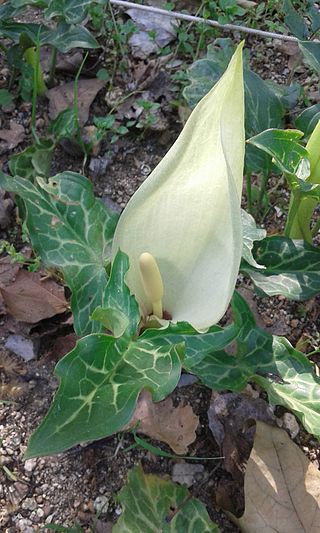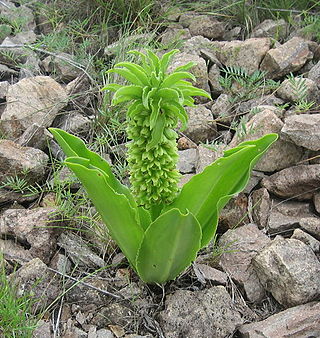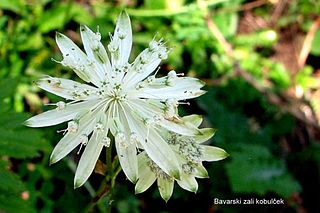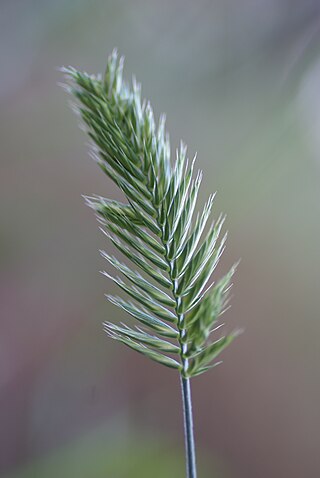
Gentiana acaulis, the stemless gentian, or trumpet gentian, is a species of flowering plant in the family Gentianaceae, native to central and southern Europe, from Spain east to the Balkans, growing especially in mountainous regions, such as the Alps and Pyrenees, at heights of 800–3,000 m (2,625–9,843 ft).

Giovanni Antonio Scopoli was an Italian physician and naturalist. His biographer Otto Guglia named him the "first anational European" and the "Linnaeus of the Austrian Empire".

Armeria maritima, the thrift, sea thrift or sea pink, is a species of flowering plant in the family Plumbaginaceae. It is a compact evergreen perennial which grows in low clumps and sends up long stems that support globes of bright pink flowers. In some cases purple, white or red flowers also occur. It is a popular garden flower and has been distributed worldwide as a garden and cut flower. It does well in gardens designed as xeriscapes or rock gardens. The Latin specific epithet maritima means pertaining to the sea or coastal.

Helvella crispa, also known as the white saddle, elfin saddle or common helvel, is an ascomycete fungus of the family Helvellaceae. The mushroom is readily identified by its irregularly shaped whitish cap, fluted stem, and fuzzy undersurfaces. It is found in eastern North America and in Europe, near deciduous trees in summer and autumn.

Arum italicum is a species of flowering herbaceous perennial plant in the family Araceae, also known as Italian arum and Italian lords-and-ladies. It is native to the British Isles and much of the Mediterranean region, the Caucasus, Canary Islands, Madeira and northern Africa. It is also naturalized in Belgium, the Netherlands, Austria, Argentina, North Island New Zealand and scattered locations in North America.

Polygaloides chamaebuxus, synonym Polygala chamaebuxus, the shrubby milkwort, is an ornamental plant in the family Polygalaceae. Its flowers are solitary or in pairs in the leaf axils. The inner two sepals, the wings, are upright and white to yellow, sometimes pinkish or purple. The keel petals are bright yellow, aging to brownish-red or purple. It is native to the Alps and the mountains of west-central Europe. It was known to be grown in cultivation in about 1658 and was illustrated by Carolus Clusius. It has been given the Royal Horticultural Society's Award of Garden Merit.

Bistorta affinis, the Himalayan bistort, fleece flower, or knotweed, is a species of flowering plant in the family Polygonaceae, native to the Himalayas.

Muscari neglectum is a perennial bulbous flowering plant in the asparagus family Asparagaceae. Members of this genus are commonly known as grape hyacinths, and M. neglectum is known as common grape hyacinth or starch grape hyacinth. Muscari are perennial bulbous plants native to Eurasia. They produce spikes of dense, commonly blue, urn-shaped flowers. It is sometimes grown as an ornamental plant, for example, in temperate climates as a spring bulb.

Symphyotrichum lateriflorum is a species of flowering plant in the aster family (Asteraceae). Commonly known as calico aster, starved aster, and white woodland aster, it is native to eastern and central North America. It is a perennial and herbaceous plant that may reach heights up to 120 centimeters and widths up to 30 centimeters.

Calamagrostis arundinacea is a species of bunch grass in the family Poaceae, native to Eurasia, China and India. Under its synonym Calamagrostis brachytricha it has gained the Royal Horticultural Society's Award of Garden Merit.

Eucomis autumnalis, the autumn pineapple flower, or autumn pineapple lily, is a species of flowering plant in the family Asparagaceae, subfamily Scilloideae, native to Malawi, Zimbabwe and southern Africa. It is a mid to late summer flowering deciduous bulbous perennial. The flower stem reaches about 40 cm (16 in), rising from a basal rosette of wavy-edged leaves. The green, yellow or white flowers are arranged in a spike (raceme), topped by a "head" of green leaflike bracts. It is grown as an ornamental garden plant and can also be used as a cut flower.

Sesleria is a genus of perennial plants in the grass family. They are native to Eurasia and North Africa. They are found in Albania, Austria, Baleares, Baltic States, Belarus, Belgium, Bulgaria, Corsica, Czechoslovakia, East Aegean Islands, Finland, France, Germany, Great Britain, Greece, Hungary, Iceland, Iran, Ireland, Italy, Crete, Crimea, Lebanon, Morocco, North Caucasus, Poland, Romania, Sardina, Sicilia, Spain, Sweden, Switzerland, Syria, Transcaucasus, Turkey, Ukraine and Yugoslavia.

Celtica gigantea, commonly called giant feather grass, giant needle grass, or golden oats, is a species of flowering plant in the grass family Poaceae, native to the Iberian Peninsula and Morocco. It is still widely referenced in the horticultural literature under its synonym Stipa gigantea.

Linnaea chinensis, commonly known as Chinese abelia, is a species of flowering plant in the honeysuckle family Caprifoliaceae. It is a semi-evergreen, densely branched shrub with dark green foliage.

Zephyranthes minuta is a plant species very often referred to as Zephyranthes grandiflora, including in Flora of North America. The latter is, however, an illegitimate name because the original author in coining the name Zephyranthes grandiflora listed the older name Amaryllis minuta as a synonym. This makes "minuta" the acceptable epithet under the ICN. In the UK it is a recipient of the Royal Horticultural Society's Award of Garden Merit.

Astrantia bavarica, common name masterwort, is a species of flowering plant in the family Apiaceae, native to Eastern alps. Growing to 30 cm (12 in) tall by 30 cm (12 in) broad, it is an herbaceous perennial, much used in gardens.

Arabis caucasica is a species of flowering plant in the mustard family (Brassicaceae) known by the common names garden arabis, mountain rock cress or Caucasian rockcress.

Wangenheimia is a monotypic genus of plants in the grass family. The only known species is Wangenheimia lima.

Acis autumnalis, the autumn snowflake, is a species of flowering plant in the family Amaryllidaceae. A short bulbous perennial, it is found on the western shores of the Mediterranean, from Portugal, Spain and Morocco to Sicily and Tunisia.

Vaccinium glaucoalbum, the grey-white blueberry, is a species of Vaccinium native to Nepal, east Himalaya, and Myanmar, and Tibet and Yunnan in China. An evergreen shrub with white-bloomed black berries, it has gained the Royal Horticultural Society's Award of Garden Merit as an ornamental. It grows in thickets and forest margins. Local people collect and eat the fruit.





















